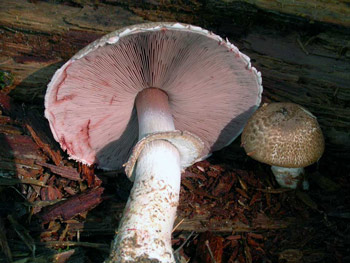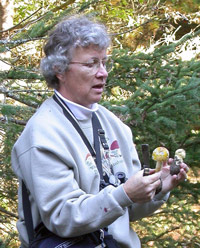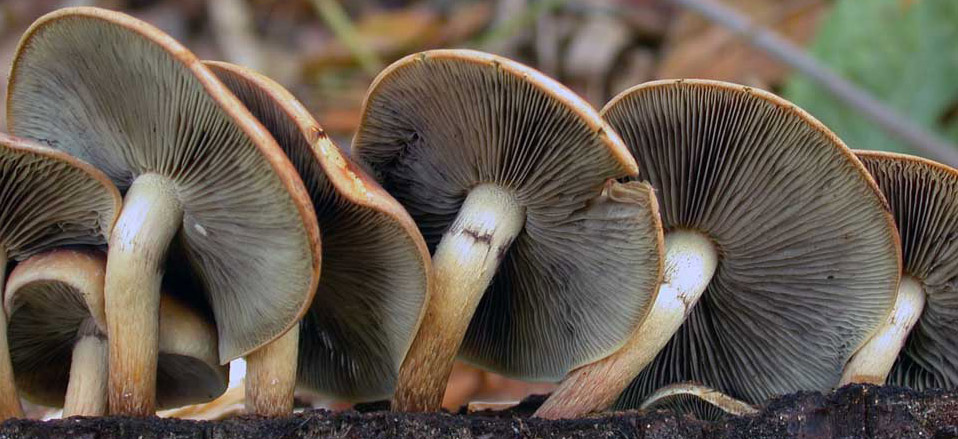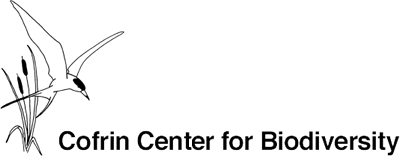Biodiversity of Macrofungi in Northern Door County, WI
Photos by Roy Lukes, Charlotte Lukes, Beth Bartoli
Species descriptions by Charlotte Lukes
Additional text by Vicki Medland
Introduction
Macrofungi or macromycetes include all of the fungi that produce spore containing structures called sporocarps that are large enough to be seen without the need of specialized optical instruments. This includes fungi in the phylum Basidiomycota that produce the familiar umbrella shaped sporocarps including the gill mushrooms and boletes, as well as Polypores, star fungi, tooth fungi, puffballs, false-truffles, jelly and crust fungi, whose sporocarps may have other shapes. Other macromycetes include morels, truffles, and cup fungi found in the phylum Ascomycota. The slime molds (Phylum Myxogastria) are often also included as well, even though they are not fungi. Of the estimated 1.5 million species of fungi in the world, only about 110,000 are macromycetes, and less than half of these are described. North America is home to about 10,000 different species of macrofungi and about 6500 of these are unique to the continent.
These pages illustrate the biodiversity of macrofungi that you might encounter in Northern Door County, WI. Species are arranged into assemblages based on habitat preference. Each photograph is linked to a detailed description of that species.The list is based on surveys by experienced fungi naturalist Charlotte Lukes who has collected data on macrofungi in Door County over the last 40 years. Jump to Species List and Biodiversity by Habitat.
What is a mushroom?
 The sporocarp is the reproductive structure of a fungus. It contains tiny sexually produced spores that are released and disperse and grow into a new individual. With the exception of a few perennial species (e.g. shelf fungi), the sporocarp is visible for a short time.
The sporocarp is the reproductive structure of a fungus. It contains tiny sexually produced spores that are released and disperse and grow into a new individual. With the exception of a few perennial species (e.g. shelf fungi), the sporocarp is visible for a short time.
The vegetative part of the fungus is composed of a mass of branching, hair-like filaments called a mycelium that grows in soil, decaying wood, or sometimes in living organisms. The filaments release enzymes that break down large carbohydrates into smaller molecules that can be absorbed, along with nutrients, and water through the walls of the hyphae. Sometimes, the mycelium will produce bundles of hyphae called rhizomorphs that are visible as white threads in soil or in decaying wood. In some species the mycelium of a single individual can expand over several acres. A single individual of Armillaria bulbosa (Honey Mushroom), located in the Upper Peninsula of Michigan, when last measured in 1992, covered 38 acres and weighed 100 tons.
Sporococarps are only produced when two compatible mycelia of the same species fuse (anastomosis) to form a dikaryotic mycelium where each cell contains 2 nuclei (one from each parent mycelia). The now binucleate mycelium continues to grow and under favorable conditions will produce sporocarps of other shapes depending on the species. As the sporocarp matures, specialized cells undergo meiosis and produce tiny spores on gills, pores or other structures on the sporocarp. Spores are released through a variety of mechanisms and are dispersed by wind, water, or by animals. If a spore lands in a favorable location the haploid spores will grow into a mycelium that will eventually fuse with a compatible mycelium.
Soil, Trees, and Fungi
All fungi must obtain energy and nutrients from the environment. Mushroom producing fungi do this either by extracting nutrients from soil, decaying plant material or by exchanging nutrients when in association with living plants. Saprophytic fungi produce enzymes that convert decaying material into simpler molecules which then can be absorbed by the mycelia. These fungi help to create compost that will in turn provide nutrients to plants and other organisms that inhabit the soil and leaf litter. Parasitic mushroom species absorb nutrients directly from a living host via mycelia that grow into the host’s tissues.
Ectomycorrhizal mushroom species are associated with living plants, but are not parasites. Instead the species exist in a mutually beneficial symbiotic association. Ectomycorrhizal hyphae intertwine with the existing plant roots and then extend far beyond it, capturing water and nutrients, especially typically immobile nutrients like phosphorus and iron, and transferring them to the plant. The fungi benefit by harvesting sugars and other molecules produced by the plants they infect. Almost all plant families include species that are mycorrhizal; some like orchids are always mycorrhizal. Many native trees, shrubs, and plants depend on mychorrhizal associations. Many familiar and economically important mushrooms like Chanterelles, boletes and truffles form ectomycorrhizal associations with several species of trees.
Forest ecosystems are dependent on the activities of saprophytic and mycorrhizal fungi that break down and transport nutrients in the soil. Soil- fungi relationships have a profound effect on forest health, succession, and biodiversity. Trees with ectomycorrhizal associations have higher biomass and are better able to survive droughts, resists diseases and insect infestations than trees without fungal associations.
Locating and Identifying Macrofungi
Macrofungi can be seen throughout the growing season but are most often found in the spring or fall of the year in the Great Lakes region. Fungal diversity depends on the types of favorable habitat and the diversity of trees that can support fungal growth. The emergence of fruiting bodies depends on the maturity of the fungal mycelium, available nutrients, temperature and moisture. Sporocarp development can be highly variable between years and among species. So in order to best document the biodiversity of a site it must be visited throughout the year over several years.
There are a number of good field guides that will help you to identify the mushrooms you might see. Even the best guides include only a fraction of the species found in North America. Unfortunately, many of the guides that are specific to the western Great Lakes region are now out of print. See the "useful references" section below for suggestions.
Can I eat that Mushroom?
These pages are meant to illustrate the biodiversity of mushrooms in northern Door County and should not be relied on for identification. Mushroom identification is generally very difficult and many edible species look very similar to poisonous species. While a good field guide can be used to identify mushrooms to the Genus level, they are usually not useful for separating one species from another, except for a few with very unique and easily recognizable characteristics. Mushrooms can change greatly in color and shape as they mature and species within a genus are often very similar, making positive identification extremely difficult without use of microscopic examination, or in some cases using molecular techniques, even by experienced experts.
You will not find information about edibility in our species descriptions because we do not advocate eating wild mushrooms for two important reasons. First, it is reckless to eat wild fungi without proper training in identification. Ninety-five percent of mushroom poisonings occur due to misidentification by inexperienced mushroom hunters. Mushroom identification is generally very difficult and many edible species look very similar to poisonous species.
Second, we do not allow the picking or destruction of any organisms on our natural areas. Our mission is to promote and enhance biodiversity. Removal of mushrooms decreases the number of spores that will germinate and grow to produce a new generation. One person harvesting mushrooms might seem harmless, but as Garrett Hardin’s classic article the “Tragedy of the Commons” illustrates, public spaces can be destroyed by overuse and exploitation. Door County’s natural areas receive thousands of visitors every year, and over-collection will lead to a decline especially in genetic diversity.
About Charlotte Lukes

Charlotte Lukes identified and wrote the the descriptions of all of the species presented here. She and her husband Roy provided all photographs unless noted. Charlotte photographed her first mushroom in 1971 and has since explored most of Door County in search of new species. She and her husband Roy are well known environmental educators in Door County and have been dedicated advocates for the protection and conservation of Door County’s natural areas. Charlotte is a founding member of “The Friends of Toft Point” and has served since its creation to build the organization and its membership. She has received numerous awards in recognition of her environmental work from organizations including the Sierra Club, The Nature Conservancy, Door County Environmental Council, and Wi Society of Ornithology.
Suggested References
- Mushroom Observer: http://mushroomobserver.org/ is an open source site that allows individuals to post observations and photos of macrofungi into a searchable database.
- Mushroom Expert: http://www.mushroomexpert.com/ includes over 900+ keys and descriptions to North American mushrooms.
- Door County Comprehensive Forest Plan (WI DNR) is a document intended to supplement the individualized forestry plan/recommendations prepared for local property owners. http://www.forestguild.org/ecological_forestry/Door_County_Comprehensive_Forestry_Plan.pdf
- Arora D. 1986. Mushrooms Demystified: A Comprehensive Guide to the Fleshy Fungi (2nd edition). Ten Speed Press. Berkeley, CA.
- Barron, G. 1999 Mushrooms of Northeast North America: Midwest to New England. Lone Pine Publishing. Auburn, WA.
- Lincoff, G. 1981. National Audubon Society Field Guide to North American Mushrooms. Kopf/ Chanticleer Press. NY, NY.
- Weber, L and C. Mollen 2007 Fascinating Fungi of the North Woods. Kollath+Stensaas Publishing, Duluth, MN.

